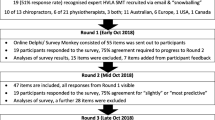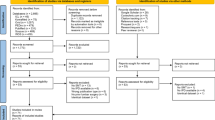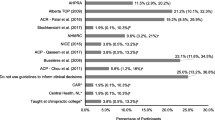Abstract
Purpose
Chiropractic spinal manipulation treatment (SMT) is common for back pain and has been reported to increase the risk for lumbar disc herniation (LDH), but there is no high quality evidence about this. In the absence of good evidence, clinicians can have knowledge and beliefs about the risk. Our purpose was to determine clinicians’ beliefs regarding the risk for acute LDH associated with chiropractic SMT.
Methods
Using a belief elicitation design, 47 clinicians (16 chiropractors, 15 family physicians and 16 spine surgeons) that treat patients with back pain from primary and tertiary care practices were interviewed. Participants’ elicited incidence estimates of acute LDH among a hypothetical group of patients with acute low back pain treated with and without chiropractic SMT, were used to derive the probability distribution for the relative risk (RR) for acute LDH associated with chiropractic SMT.
Results
Chiropractors expressed the most optimistic belief (median RR 0.56; IQR 0.39–1.03); family physicians expressed a neutral belief (median RR 0.97; IQR 0.64–1.21); and spine surgeons expressed a slightly more pessimistic belief (median RR 1.07; IQR 0.95–1.29). Clinicians with the most optimistic views believed that chiropractic SMT reduces the incidence of acute LDH by about 60% (median RR 0.42; IQR 0.29–0.53). Those with the most pessimistic views believed that chiropractic SMT increases the incidence of acute LDH by about 30% (median RR 1.29; IQR 1.11–1.59).
Conclusions
Clinicians’ beliefs about the risk for acute LDH associated with chiropractic SMT varied systematically across professions, in spite of a lack of scientific evidence to inform these beliefs. These probability distributions can serve as prior probabilities in future Bayesian analyses of this relationship.

Similar content being viewed by others
References
Gouveia LO, Castanho P, Ferreira JJ (2009) Safety of chiropractic interventions: a systematic review. Spine 34:E405–E413
Snelling NJ (2006) Spinal manipulation in patients with disc herniation: a critical review of risk and benefit. Int J Osteopath Med 9:77–84
Cherkin DC, Sherman KJ, Deyo RA, Shekelle PG (2003) A review of the evidence for the effectiveness, safety, and cost of acupuncture, massage therapy, and spinal manipulation for back pain. Ann Intern Med 138:898–906
Furlan AD, Yazdi F, Tsertsvadze A, Gross A, Van Tulder M et al (2012) A systematic review and meta-analysis of efficacy, cost-effectiveness, and safety of selected complementary and alternative medicine for neck and low-back pain. Evid Based Complement Altern Med 2012:953139
Santilli V, Beghi E, Finucci S (2006) Chiropractic manipulation in the treatment of acute back pain and sciatica with disc protrusion: a randomized double-blind clinical trial of active and simulated spinal manipulations. Spine J 6:131–137
McMorland G, Suter E, Casha S, du Plessis SJ, Hurlbert RJ (2010) Manipulation or microdiskectomy for sciatica? A prospective randomized clinical study. J Manip Physiol Ther 33:576–584
Bronfort G, Hondras MA, Schulz CA, Evans RL, Long CR et al (2014) Spinal manipulation and home exercise with advice for subacute and chronic back-related leg pain: a trial with adaptive allocation. Ann Intern Med 161:381–391
Huang SL, Liu YX, Yuan GL, Zhang J, Yan HW (2015) Characteristics of lumbar disc herniation with exacerbation of presentation due to spinal manipulative therapy. Medicine 94:e661
Assendelft WJ, Bouter LM, Knipschild PG (1996) Complications of spinal manipulation: a comprehensive review of the literature. J Fam Pract 42:475–480
Powell FC, Hanigan WC, Olivero WC (1993) A risk/benefit analysis of spinal manipulation therapy for relief of lumbar or cervical pain. Neurosurgery 33:73–79
Schmidley JW, Koch T (1984) The noncerebrovascular complications of chiropractic manipulation. Neurology 34:684–685
Morandi X, Riffaud L, Houedakor J, Amlashi SF, Brassier G et al (2004) Caudal spinal cord ischemia after lumbar vertebral manipulation. Jt Bone Spine 71:334–337
Tamburrelli FC, Genitiempo M, Logroscino CA (2011) Cauda equina syndrome and spine manipulation: case report and review of the literature. Eur Spine J 20(Suppl 1):S128–S131
Oppenheim JS, Spitzer DE, Segal DH (2005) Nonvascular complications following spinal manipulation. Spine J 5:660–667
Gifford F (2001) Uncertainty about clinical equipoise. Clinical equipoise and the uncertainty principles both require further scrutiny. BMJ 322:795
Spiegelhalter DJ (2004) Incorporating Bayesian ideas into health-care evaluation. Stat Sci 19:156–174
Spiegelhalter DJ, Myles JP, Jones DR, Abrams KR (1999) Methods in health service research. An introduction to bayesian methods in health technology assessment. BMJ 319:508–512
Spiegelhalter DJ, Rice K (2009) Bayesian statistics. Scholarpedia 4:5230
O’Hagan A, Buck CE, Daneshkhah A, Eiser JR, Garthwaite PH et al (2006) Uncertain judgements: eliciting experts’ probabilities. Wiley, West Sussex
Lilford RJ, Thornton JG, Braunholtz D (1995) Clinical trials and rare diseases: a way out of a conundrum. BMJ 311:1621–1625
Dunson DB (2001) Commentary: practical advantages of Bayesian analysis of epidemiologic data. Am J Epidemiol 153:1222–1226
Hampson LV, Whitehead J, Eleftheriou D, Brogan P (2014) Bayesian methods for the design and interpretation of clinical trials in very rare diseases. Stat Med 33:4186–4201
Johnson SR, Tomlinson GA, Hawker GA, Granton JT, Feldman BM (2010) Methods to elicit beliefs for Bayesian priors: a systematic review. J Clin Epidemiol 63:355–369
Johnson SR, Tomlinson GA, Hawker GA, Granton JT, Grosbein HA et al (2010) A valid and reliable belief elicitation method for Bayesian priors. J Clin Epidemiol 63:370–383
Johnson SR, Granton JT, Tomlinson GA, Grosbein HA, Hawker GA et al (2011) Effect of warfarin on survival in scleroderma-associated pulmonary arterial hypertension (SSc-PAH) and idiopathic PAH. Belief elicitation for Bayesian priors. J Rheumatol 38:462–469
Diamond IR, Grant RC, Feldman BM, Tomlinson GA, Pencharz PB et al (2014) Expert beliefs regarding novel lipid-based approaches to pediatric intestinal failure–associated liver disease. J Parenter Enteral Nutr 38:702–710
Hincapié CA (2015) Chiropractic care and risk for acute lumbar disc herniation: a mixed methods approach. Dissertation, University of Toronto
Oakley JE, O’Hagan A (2010) SHELF: the Sheffield Elicitation Framework (version 2.0). School of Mathematics and Statistics, University of Sheffield. http://tonyohagan.co.uk/shelf. Accessed 19 Dec 2012
R Development Core Team (2011) R: a language and environment for statistical computing. R Foundation for Statistical Computing. http://www.R-project.org. Accessed 30 Jan 2013
Billingham L, Malottki K, Steven N (2012) Small sample sizes in clinical trials: a statistician’s perspective. Clin Investig 2:655–657
Chaloner K, Rhame FS (2001) Quantifying and documenting prior beliefs in clinical trials. Stat Med 20:581–600
Deandrea S, Negri E, Ruggeri F (2014) Integrating clinicians’ opinion in the Bayesian meta-analysis of observational studies: the case of risk factors for falls in community-dwelling older people. Epidemiol Biostat Public Health (Online) 11:e8909
Morris DE, Oakley JE, Crowe JA (2014) A web-based tool for eliciting probability distributions from experts. Environ Model Softw 52:1–4
Myburgh C, Mouton J (2008) The development of contemporary chiropractic education in Denmark: an exploratory study. J Manip Physiol Ther 31:583–592
Humphreys BK, Peterson CK, Muehlemann D, Haueter P (2010) Are Swiss chiropractors different than other chiropractors? Results of the job analysis survey 2009. J Manip Physiol Ther 33:519–535
Chenot JF, Becker A, Leonhardt C, Keller S, Donner-Banzhoff N et al (2007) Use of complementary alternative medicine for low back pain consulting in general practice: a cohort study. BMC Complement Altern Med 7:42
Paige NM, Miake-Lye IM, Booth MS, Beroes JM, Mardian AS et al (2017) Association of spinal manipulative therapy with clinical benefit and harm for acute low back pain: systematic review and meta-analysis. JAMA 317:1451–1460
National Guideline Centre (UK) (2016) Low back pain and sciatica in over 16s: assessment and management—12, manual therapies. In: NICE Guideline, no. 59. National Institute for Health and Care Excellence (UK), London. https://ncbi.nlm.nih.gov/books/NBK410141/. Accessed 17 July 2017
Acknowledgements
We thank Drs. Sindhu Johnson and Ivan Diamond for their assistance with the development of the belief elicitation interview and questionnaire. We acknowledge Drs. Jeremy Oakley and Anthony O’Hagan for their development and open source sharing of the SHELF elicitation framework. We thank all the clinician experts who participated in the belief elicitation interviews.
Author information
Authors and Affiliations
Contributions
CAH conceived and designed the study, acquired, cleaned and analysed the data, interpreted the results, and drafted and revised the paper. GT conceived and designed the study, analysed the data, interpreted the results, and revised the paper. PC, YRR, ARJ and JDC designed the study, interpreted the results, and revised the paper. CAH acts as guarantor.
Corresponding author
Ethics declarations
Funding sources
Canadian Institutes of Health Research [Grant ID: 200902KPD-205299-111612], and Canadian Chiropractic Research Foundation.
Conflict of interest
All authors have completed the ICMJE uniform disclosure form at http://www.icmje.org/coi_disclosure.pdf (available from the corresponding author) and declare: CAH was funded by Fellowship Awards in the Area of Knowledge Translation from Canadian Institutes of Health Research [Grant ID: 200902KPD-205299-111612] and Canadian Chiropractic Research Foundation, PC is funded by a Canada Research Chair in Disability Prevention and Rehabilitation at the University of Ontario Institute of Technology; PC consults for European Spine Society, National Judicial Institute of Canada, Canadian Memorial Chiropractic College, Canadian Chiropractic Protective Association, Society of Musculoskeletal Manual Practitioners of Saskatchewan, Société des experts en évaluation médico-légale du Québec, YRR consults for Medtronic, outside the submitted work; no other relationships or activities that could appear to have influenced the submitted work. The funders played no role in the design and conduct of the study; collection, management, analysis, and interpretation of the data; and preparation, review, or approval of the manuscript.
Ethical approval
This study was approved by the research ethics board at the University Health Network (REB #11-0240-AE).
Data sharing
No additional data available.
Electronic supplementary material
Below is the link to the electronic supplementary material.
Rights and permissions
About this article
Cite this article
Hincapié, C.A., Cassidy, J.D., Côté, P. et al. Chiropractic spinal manipulation and the risk for acute lumbar disc herniation: a belief elicitation study. Eur Spine J 27, 1517–1525 (2018). https://doi.org/10.1007/s00586-017-5295-0
Received:
Accepted:
Published:
Issue Date:
DOI: https://doi.org/10.1007/s00586-017-5295-0




